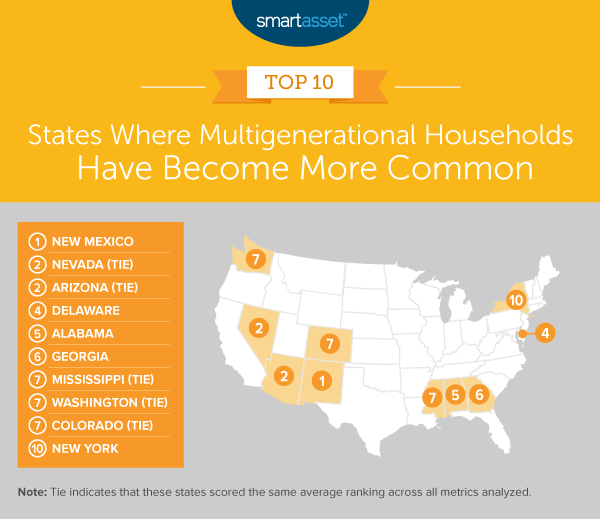The U.S. Census Bureau says that multigenerational households are more common among recent immigrants who live with relatives and families residing in areas that have housing shortages or high real estate costs. Other economic factors like mounting student debt and lack of employment can also drive people to move in with family in order to save money. Such households exist around the country and can work with a financial advisor to create a strategy that stretches their dollar further, but those living in these types of arrangements are not evenly distributed nationwide. With that in mind, SmartAsset has crunched the numbers to see which states have more multigenerational households.
To do this, we compared data from the total number of multigenerational households in 2015, 2018 and 2019 in all 50 states and the District of Columbia. For details on our data sources and how we put all the information together to create our final rankings, check out the Data and Methodology section below.
This is SmartAsset’s second study on the most and least severely housing cost-burdened cities. Check out the 2020 version here.
Key Findings
- Only three states repeat in the top 10. Seven out of the highest-ranking states in our study were not in the top 10 from 2020. Nevada, Arizona and Georgia are the only three states that repeat (Nevada and Arizona tie for second place and Georgia ranks sixth). Alaska, which ranked first in last year’s study, fell in 2021 to 45th place this year; it experienced a drop in both the four-year and one-year changes in number of multigenerational households.
- Western and Southern states still dominate. According to Census regional divisions, half of the top 10 states are in the West (New Mexico, Nevada, Arizona, Washington and Colorado) and another four are in the South (Delaware, Alabama, Georgia and Mississippi). Only New York stands out as a Northeastern state.

1. New Mexico
New Mexico ranks in the top 10 for all three metrics that were measured for this study. It has the second-highest four-year increase in the number of multigenerational households, jumping 16.73% between 2015 and 2019. It had a 12.66% increase between 2018 and 2019, the sixth-highest one-year change. And 4.30% of all households in the Land of Enchantment are multigenerational, the 10th-highest in the study.
2. Nevada (tie)
Nevada saw the third-highest jump in the number of multigenerational homes between 2015 and 2019, a jump of 16.68%, and the 12th-highest jump between 2018 and 2019, with a 5.92% spike. Of the total number of households in the Silver State, 4.44% are multigenerational in 2019, the seventh-highest nationwide.
2. Arizona (tie)
Arizona saw a 15.32% leap in the number of multigenerational households between 2015 and 2019, the fifth-highest four-year increase that we observed. In 2019, 4.48% of all households were multigenerational, the sixth-highest in the study.
4. Delaware
Delaware has seen a big increase in multigenerational homes very recently. Between 2018 and 2019, the total went up by 16.20%, the third-highest increase in the study for this metric. The First State places 10th for its four-year change between 2015 and 2019, increasing 12.17%.
5. Alabama
Alabama has the 10th-highest one-year change in multigenerational homes between 2018 and 2019, increasing 8.55%. This state also rose 8.81% between 2015 and 2019, the 14th-highest increase for multigenerational homes during those four years.
6. Georgia
Georgia has the eighth-highest percentage of multigenerational households, coming in at 4.39%. The Peach State finishes in the top half of our study for the other two metrics as well, coming in 17th for the one-year change in multigenerational homes between 2018 and 2019 (3.72%), and 21st for the four-year change between 2015 and 2019 (4.13%).
7. Mississippi (tie)
Multigenerational households in Mississippi made up 4.72% of all households in 2019, ranking fourth in our study. However, this is the only state in the top 10 with a decrease in multigenerational households between 2015 and 2019. Despite the fact that Mississippi has the eighth-lowest four-year change in multigenerational households – decreasing 9.57% from 2015 to 2019 – the state also has the fourth-highest one-year increase, growing 15.92% between 2018 and 2019.
7. Washington (tie)
Washington State has the fourth-highest four-year change in multigenerational households, growing 16.53% between 2015 and 2019. The state only grew 2.22% between 2018 and 2019, finishing 23rd for this metric, and has the 25th-highest 2019 percentage of multigenerational households, with 3.25%.
7. Colorado (tie)
Colorado saw the ninth-highest one-year jump in multigenerational households between 2018 and 2019, increasing 8.86%. Between 2015 and 2019, multigenerational households went up 9.49%, the 13th-highest increase in the study.
10. New York
New York rounds out the top 10 of this study with multigenerational households making up 4.32% of all households statewide in 2019, the ninth-highest percentage in our study. Multigenerational homes in the state grew 2.57% between 2018 and 2019, and 3.26% between 2015 and 2019.

Data and Methodology
To find the states where multigenerational households are becoming more common, SmartAsset looked at data for all 50 states and the District of Columbia across the following three metrics:
- Multigenerational households as a percentage of all households in 2019. Data comes from the Census Bureau’s 2019 1-year American Community Survey.
- One-year percentage change in the number of multigenerational households. This is for 2018 to 2019. Data comes from the Census Bureau’s 2018 and 2019 1-year American Community Surveys.
- Four-year percentage change in the number of multigenerational households. This is for 2015 to 2019. Data comes from the Census Bureau’s 2015 and 2019 1-year American Community Surveys.
We ranked each state in every metric, giving a full weighting to all three metrics. We then found each state’s average ranking and used the average to determine a final score. The state with the highest average ranking received a score of 100. The state with the lowest average ranking received a score of 0.
Tips for Buying a Home for Your Multigenerational Family
- Branch out to support a growing family tree. If you want to buy a home of your own that can house members of your family from multiple generations, consider working with a financial advisor to get your finances in order first. SmartAsset’s free tool matches you with financial advisors in your area in five minutes. If you’re ready to be matched with professional advisors, get started now.
- Understand your limits. Make sure you know how much house you can afford before you start the process, so you don’t waste your time looking out of your price range.
- Build a budget you can bet on. One way to save money to buy a home is by setting a budget and including a monthly deposit into a house fund. Use SmartAsset’s budget calculator to get started.
Questions about our study? Contact press@smartasset.com.
Photo credit: ©iStock.com/kupicoo
